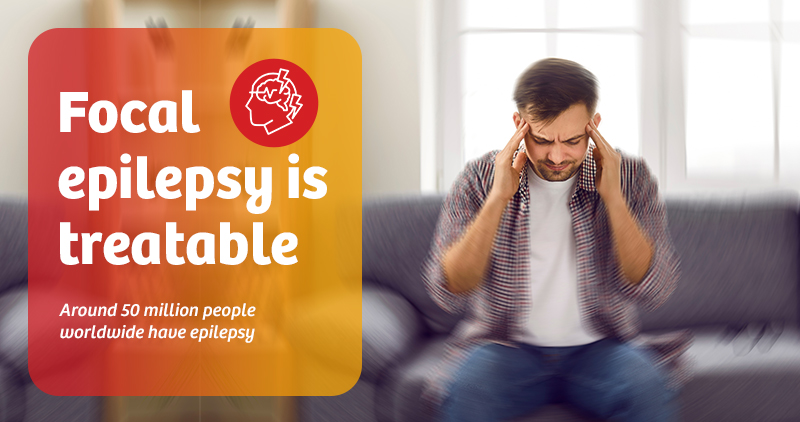

By Dr Abhishek Gohel
Consultant Neurologist & Epileptologist
Dec 23 , 2024
Around 50 million people worldwide have epilepsy, making it one of the most common neurological diseases globally. It can happen if excessive abnormal electrical discharges affect a particular part of the brain or whole of the brain.
Let us understand focal epilepsy in detail.
Focal epilepsy, also known as partial epilepsy, is a type of epilepsy that originates in a specific area of the brain. Unlike generalised epilepsy, where seizures involve the entire brain, focal seizures start in one region of the brain and can spread to other areas or remain localised. Focal epilepsy can affect individuals of all ages and may manifest in various forms, depending on which part of the brain is involved.
Focal Onset Aware Seizures (Simple Partial Seizures): In this type, the person remains conscious and aware during the seizure, although they may experience unusual sensations or movements. These sensations are called “aura” - the patient might perceive these auras as “signals” before or during the start of seizures.
Focal Onset Impaired Awareness Seizures (Complex Partial Seizures): In this case, consciousness is impaired or altered. The person may appear confused or unresponsive during the seizure.
Secondary Generalised Seizures: Secondary generalised seizures occur when seizure activity initiates in a localized region of the brain, but then spreads to involve the entire brain, leading to a generalized seizure presentation. This is when usually the seizures are noticed by the onlookers.
Focal epilepsy can result from various factors, and in many cases, the exact cause remains unknown. However, there are several common triggers and risk factors, including:
Brain injury or trauma: A traumatic brain injury (TBI), such as from an accident or a fall, can damage specific areas of the brain, leading to focal epilepsy.
Brain tumours: Tumors in certain regions of the brain can cause abnormal electrical activity and trigger seizures.
Infections: Infections like meningitis or encephalitis, which cause inflammation in the brain, can result in focal seizures.
Stroke: A stroke can disrupt the normal blood flow to the brain, leading to brain damage and an increased risk of seizures.
Genetic factors: Some forms of focal epilepsy may have a genetic basis, although the range of exact genetic mutations responsible are still being studied.
Structural abnormalities: Conditions like focal cortical dysplasias (FCDs) (abnormal brain development) or brain malformations can predispose individuals to focal seizures. These are commonly missed on low resolution MRI.
The symptoms of focal epilepsy can vary widely depending on which part of the brain is affected. Some of the common signs of focal seizures include:
Diagnosing focal epilepsy involves several steps to determine the exact nature and origin of the seizures. Common diagnostic procedures include:
Medical history and physical examination: A thorough evaluation of the patient's medical history and a physical examination help the doctor understand the frequency, duration, and nature of the seizures.
Video-Electroencephalogram (Video-EEG): A Video-EEG is a tool that helps to establish the nature of events, the area of onset of seizures, and if the seizures is focal onset, or multifocal onset, or generalised onset.
Magnetic Resonance Imaging (MRI): MRI scans can provide detailed images of the brain and help identify structural abnormalities, tumours, or lesions that may be causing the seizures.
Positron Emission Tomography (PET) or Single-Photon Emission Computed Tomography (SPECT): These imaging techniques can help pinpoint the specific brain regions involved in focal seizures.
Neuropsychological testing: In some cases, additional testing may be performed to assess cognitive and emotional function, which can help identify areas of the brain that may be affected by seizures. This is helpful for long term neuropsychological rehabilitation of patients with epilepsy.
The treatment for focal epilepsy aims to control seizures and improve the individual's quality of life. Treatment options may include:
1. Medications:
2. Surgery:
Focal epilepsy is a condition that can significantly impact a person's life, but with modern diagnostic tools and treatment options, it is possible to manage and control seizures effectively, with improved Quality of Life (QoL).. Whether through medication, or surgery there are many ways to reduce the burden of focal epilepsy and help individuals live more comfortably and safely. At KD Hospital we have Gujarat’s best epileptologist with a comprehensive Epilepsy Care Centre with two Epileptologists (Epilepsy Specialist Neurologists) and Neurosurgical team under one roof who work to treat focal epilepsy with a rational and scientific approach.